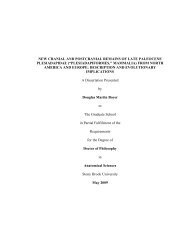Changes in nearest-neighbor associations in a captive group of ...
Changes in nearest-neighbor associations in a captive group of ...
Changes in nearest-neighbor associations in a captive group of ...
You also want an ePaper? Increase the reach of your titles
YUMPU automatically turns print PDFs into web optimized ePapers that Google loves.
262 McCann and Rothman<br />
INTRODUCTION<br />
The western lowland gorilla (Gorilla gorilla gorilla) is one <strong>of</strong> many threatened<br />
species <strong>in</strong> cooperative breed<strong>in</strong>g programs <strong>in</strong> zoological parks around the world. The<br />
wild population is estimated to be at least 100,000, whereas the eastern lowland (G.<br />
g. graueri) and mounta<strong>in</strong> (G. g. ber<strong>in</strong>gei) gorilla number 16,000 and 600, respectively<br />
[Oates, 1996]. Although the data on wild populations show that they are threatened<br />
<strong>in</strong> most countries where they occur [Stewart and Harcourt, 1987; Harcourt,<br />
1995], the North American <strong>captive</strong> population <strong>of</strong> western lowland gorillas has <strong>in</strong>creased<br />
significantly <strong>in</strong> recent years to more than 350 [Wharton et al., 1992; Wharton,<br />
1997]. Successfully reproduc<strong>in</strong>g gorillas require an adequate diet, large, stimulat<strong>in</strong>g<br />
enclosures, and suitable breed<strong>in</strong>g <strong>group</strong>s [Maple, 1979; Maple and H<strong>of</strong>f, 1982]. These<br />
requirements are not always easily atta<strong>in</strong>ed, s<strong>in</strong>ce the gorilla’s habitat is difficult to<br />
reproduce with<strong>in</strong> the conf<strong>in</strong>es <strong>of</strong> a controlled environment [Maple and F<strong>in</strong>lay, 1986].<br />
However, great strides have been made <strong>in</strong> the management <strong>of</strong> <strong>captive</strong> gorillas that<br />
have come about through the American Zoo and Aquarium Association’s (AZA) Western<br />
Lowland Gorilla Species Survival Plan (SSP). In particular, the facilitation <strong>of</strong><br />
appropriate social <strong>group</strong><strong>in</strong>gs for <strong>captive</strong> gorillas is <strong>in</strong> large part responsible for the<br />
success <strong>in</strong> reproduction and <strong>in</strong>crease <strong>in</strong> birth rates experienced <strong>in</strong> this population<br />
[Ogden and Wharton, 1997].<br />
Whereas birth rates <strong>in</strong> captivity have <strong>in</strong>creased substantially over the past 10<br />
years, and the percentage <strong>of</strong> hand-reared <strong>in</strong>fant gorillas has decreased (e.g.,






